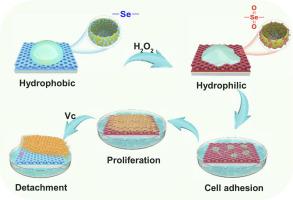Journal of Colloid and Interface Science ( IF 9.4 ) Pub Date : 2022-12-28 , DOI: 10.1016/j.jcis.2022.12.133 Zongcheng Li 1 , Yuting Shang 1 , Lu Liu 2 , Hu Long 2 , Yujun Feng 1 , Laurent Billon 3 , Hongyao Yin 1

|
Hypothesis.
Selenium (Se)-containing compound is sensitive to redox stimulation, showing hydrophobic-hydrophilic reversible transition. Introduction of such compound into honeycomb film could confer on it redox-switchable surface wettability, which is expected to control cell adhesion/detachment behavior.
Experiments.
Didodecyl selenide was designed and mixed with polystyrene to prepare honeycomb films using “breath figure” method. The film microstructures were characterized by scanning electron microscope and atomic force microscopy, and the arrangement of Se atoms in honeycomb film was determined by X-ray photoelectron spectroscopy and energy dispersive spectrometry. The variation of film wettability upon the alternating stimulation of H2O2 and Vc was examined. Then the cell adhesion, proliferation, and controlled detachment on honeycomb films were conducted.
Findings.
The introduction of didodecyl selenide helps to form ordered honeycomb film, and Se atoms were found to located on the bottom, pore walls, and top surface of the film. The presence of didodecyl selenide not only greatly improves film biocompatibility by enhancing cell thioredoxin reductase activity, but also imparts the film with H2O2–/vitamin C-regulated tunable wettability that controls cell adhesion and detachment. H2O2 treatment produces a hydrophilic surface for cell adhesion and proliferation, whereas the addition of vitamin C generates hydrophobic surfaces and allows cells to detach while remaining alive with high activity.
中文翻译:

用于控制细胞粘附/分离的具有可氧化还原转换表面的硒装饰生物相容性蜂窝膜
假设。
含硒 (Se) 化合物对氧化还原刺激敏感,表现出疏水-亲水可逆转变。将这种化合物引入蜂窝膜可以赋予其氧化还原可切换的表面润湿性,这有望控制细胞粘附/分离行为。
实验。
设计了双十二烷基硒化物并与聚苯乙烯混合,使用“呼吸图”法制备蜂窝薄膜。采用扫描电子显微镜和原子力显微镜对薄膜微观结构进行了表征,采用X射线光电子能谱和能谱法测定了蜂窝薄膜中Se原子的排列。检查了H 2 O 2和Vc交替刺激时薄膜润湿性的变化。然后进行蜂窝膜上的细胞粘附、增殖和可控脱离。
发现。
双十二烷基硒化物的引入有助于形成有序的蜂窝状薄膜,Se原子位于薄膜的底部、孔壁和顶面。双十二烷基硒化物的存在不仅通过增强细胞硫氧还蛋白还原酶活性大大提高了薄膜的生物相容性,而且还赋予薄膜 H 2 O 2 -/维生素 C 调节的可调节润湿性,从而控制细胞粘附和分离。H 2 O 2处理产生用于细胞粘附和增殖的亲水表面,而添加维生素C产生疏水表面并允许细胞分离,同时保持高活性。




















































 京公网安备 11010802027423号
京公网安备 11010802027423号